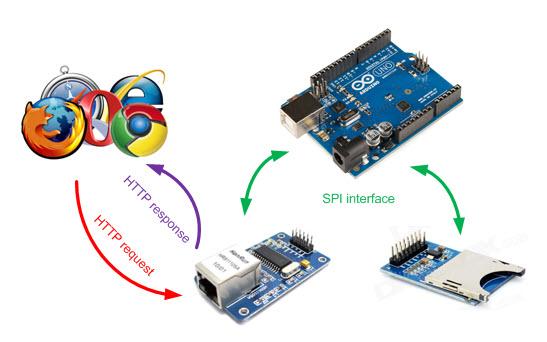Summary of SDWebServer – enc28J60 and Arduino
This article describes creating a complete webserver using an Arduino with an ENC28J60 Ethernet module and an SD card module connected via the SPI bus. The Arduino sketch handles both static resources, served from the SD card, and dynamic requests like AJAX. The key challenge is managing SPI bus chip select (CS) pins because shields often conflict on the same CS pin. The solution uses separate modules wired individually, assigning CS to pin 4 for the SD card and pin 10 for ENC28J60, allowing proper communication and resource serving.
Parts used in the Complete Webserver Project:
- Arduino board
- ENC28J60 Ethernet module
- SD card module
- Wires for connections (MOSI, MISO, CLK, CS, power, ground)
In the previous blog post, you learned how to send big files (html pages, images…) with your ENC28J60 shield. Today I’m going to show you a complete webserver!3
Description
The user’s browser sends a request, through the network, to the ENC28J60 module. The request is analyzed by the sketch that is running on the Arduino, which also prepares the response. Both the ENC28J60 module and the SD card one are connected to the Arduino via SPI bus:
The webserver handles both static and dynamic resources:
- the static resources (html pages, images…) are fetched from the SD card
- the dynamic resources (AJAX requests…) are handled by the sketch itself
The sketch leverages the method described in my previous post to send static resources of any size.
Connections
Both the SD module and the ethernet one uses the SPI bus. That bus allows to connect more than one device at a time; thanks to a PIN (called chip-select) Arduino can decide which device will handle the command it is sending on the bus. You therefore need to connect the CS PINs of the different modules to different PINs of your Arduino and to configure the libraries accordingly.
Unfortunately I noticed that often the shields use the same PIN (for example PIN 10) as CS PIN or that – worse – they don’t allow to stack other SPI shields.I was forced to use two modules (instead of shields) and to connect them using wires:
The connections are:
- power supply (5V and ground);
- MOSI (Arduino->Device), PIN 11
- MISO (Device->Arduino), PIN 12
- CLK (clock), PIN 13
- CS (chip select) ->for the SD module PIN 4, for the ENC28J60 modyule PIN 10
The two PINs I chose to be chip select PINs are configured at the top of the sketch:
For more detail: SDWebServer – enc28J60 and Arduino

